Different types of applications require different types of sensors to collect data from the environment. This article takes a look at some common IoT sensors
In an Internet of Things (IoT) ecosystem, two things are very important: the Internet and physical devices like sensors and actuators. As shown in Fig. 1, the bottom layer of the IoT system consists of sensor connectivity and network to collect information. This layer is an essential part of the IoT system and has network connectivity to the next layer, which is the gateway and network layer.
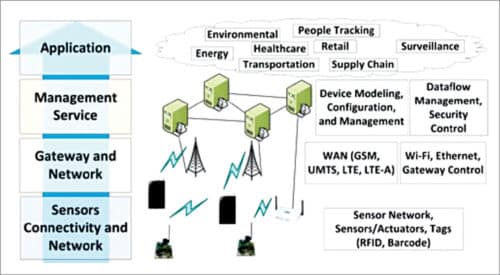
The main purpose of sensors is to collect data from the surrounding environment. Sensors, or ‘things’ of the IoT system, form the front end. These are connected directly or indirectly to IoT networks after signal conversion and processing. But all sensors are not the same and different IoT applications require different types of sensors. For instance, digital sensors are straightforward and easy to interface with a microcontroller using Serial Peripheral Interface (SPI) bus. But for analogue sensors, either analogue-to-digital converter (ADC) or Sigma-Delta modulator is used to convert the data into SPI output.
Some common types of IoT sensors
Temperature sensors
These devices measure the amount of heat energy generated from an object or surrounding area. They find application in air-conditioners, refrigerators and similar devices used for environmental control. They are also used in manufacturing processes, agriculture and health industry.
Temperature sensors can be used almost in every IoT environment, from manufacturing to agriculture. In manufacturing, sensors are used to monitor the temperature of machines. In agriculture, these can be used to monitor the temperature of soil, water and plants.
Temperature sensors include thermocouples, thermistors, resistor temperature detectors (RTDs) and integrated circuits (ICs). Some common types of temperature sensors are shown in Fig. 2.
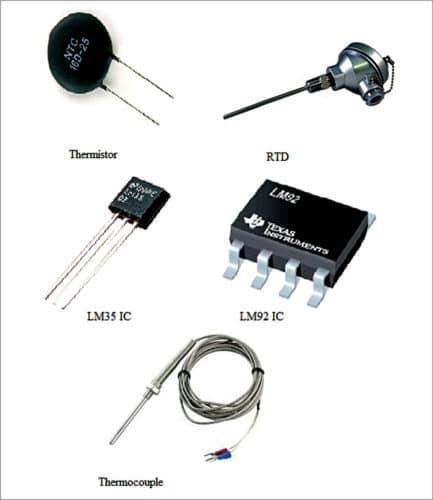
Humidity sensors
The amount of water vapour in air, or humidity, can affect human comfort as well as many manufacturing processes in industries. So monitoring humidity level is important. Most commonly used units for humidity measurement are relative humidity (RH), dew/frost point (D/F PT) and parts per million (PPM).
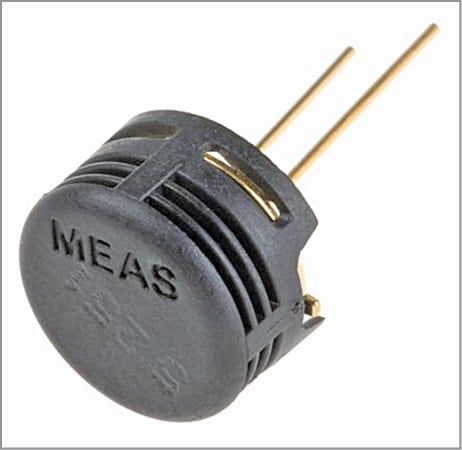
Motion sensors
Motion sensors are not only used for security purposes but also in automatic door controls, automatic parking systems, automated sinks, automated toilet flushers, hand dryers, energy management systems, etc. You use these sensors in the IoT and monitor them from your smartphone or computer. HC-SR501 passive infrared (PIR) sensor is a popular motion sensor for hobby projects.
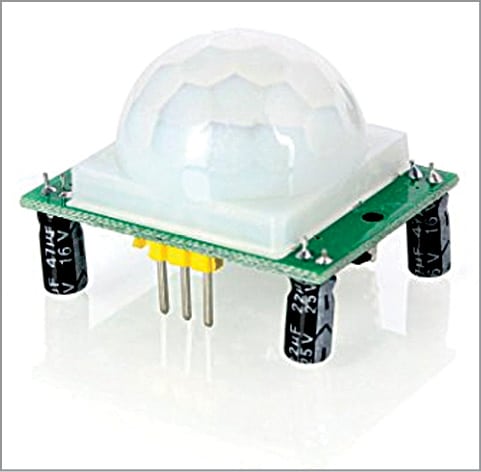
Gas sensors
These sensors are used to detect toxic gases. The sensing technologies most commonly used are electrochemical, photo-ionisation and semiconductor. With technical advancements and new specifications, there are a multitude of gas sensors available to help extend the wired and wireless connectivity deployed in IoT applications.
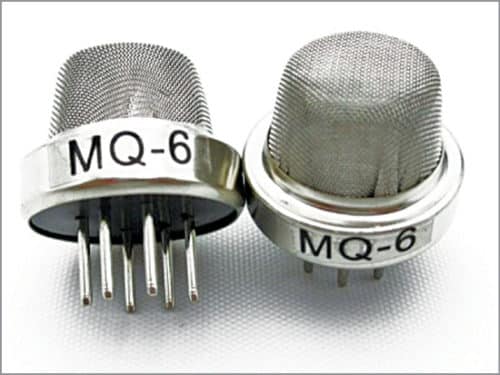
Smoke sensors
Smoke detectors have been in use in homes and industries for quite a long time. With the advent of the IoT, their application has become more convenient and user-friendly. Furthermore, adding a wireless connection to smoke detectors enables additional features that increase safety and convenience.
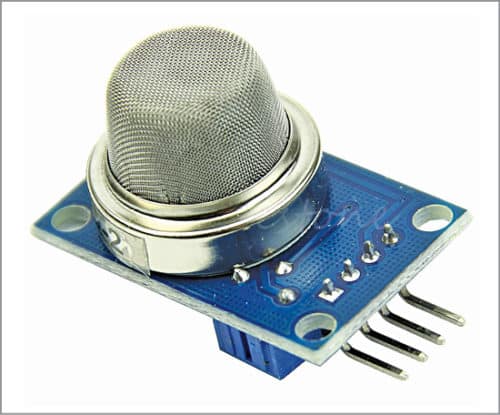
Pressure sensors
These sensors are used in IoT systems to monitor systems and devices that are driven by pressure signals. When the pressure range is beyond the threshold level, the device alerts the user about the problems that should be fixed. For example, BMP180 is a popular digital pressure sensor for use in mobile phones, PDAs, GPS navigation devices and outdoor equipment. Pressure sensors are also used in smart vehicles and aircrafts to determine force and altitude, respectively. In vehicle, tyre pressure monitoring system (TPMS) is used to alert the driver when tyre pressure is too low and could create unsafe driving conditions.
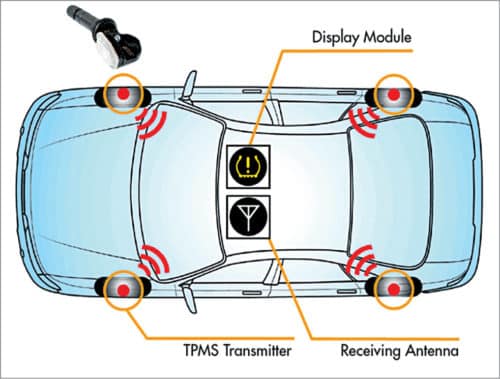
Image sensors
These sensors are found in digital cameras, medical imaging systems, night-vision equipment, thermal imaging devices, radars, sonars, media house and biometric systems. In the retail industry, these sensors are used to monitor customers visiting the store through IoT network. In offices and corporate buildings, they are used to monitor employees and various activities through IoT networks.

Accelerometer sensors
These sensors are used in smartphones, vehicles, aircrafts and other applications to detect orientation of an object, shake, tap, tilt, motion, positioning, shock or vibration. Different types of accelerometers include Hall-effect accelerometers, capacitive accelerometers and piezoelectric accelerometers.
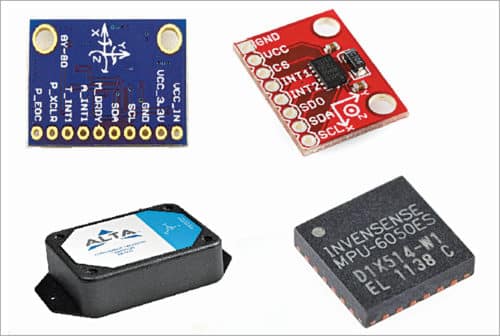
IR sensors
These sensors can measure the heat emitted by objects. They are used in various IoT projects including healthcare to monitor blood flow and blood pressure, smartphones to use as remote control and other functions, wearable devices to detect amount of light, thermometers to monitor temperature and blind-spot detection in vehicles.
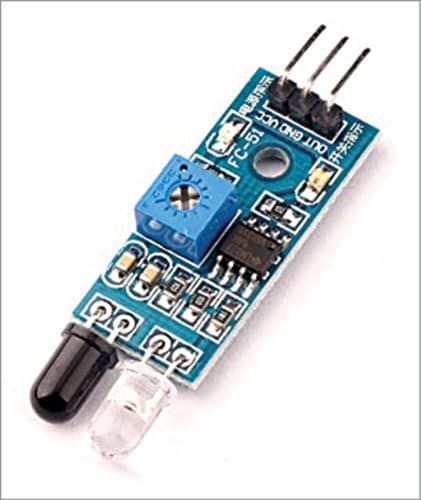
Proximity sensors
These sensors detect the presence or absence of a nearby object without any physical contact. Different types of proximity sensors are inductive, capacitive, photoelectric, ultrasonic and magnetic. These are mostly used in object counters, process monitoring and control.

IoT platform
An IoT device is connected with other IoT devices, providing data through Internet transfer protocols. So the two main divisions in an IoT system are the network and IoT platform at the back-end and the sensors and actuators at the front-end.
Most of the IoT platforms are dependent on sensors. There are many IoT platforms available but two main IoT platforms that stand out are industrial and consumer. Both these platforms slightly differ in their applications and requirements. The industrial IoT platform must be stable, reliable and secure as the platform failure may cost millions of dollars or even lives. On the other hand, a failure in consumer IoT platform can be just an inconvenience to you.
However, there are some common parameters to be considered when choosing the best IoT platform for your application. Some of these parameters include reliability, stability, flexibility, security support, pricing model, mobile/web application support, ability to handle a number of connected products, data retention or backup when power or network connection fails, and the speed and time to launch the product.
Some of the IoT platforms are listed below.
ThingSpeak
It is a cross-platform, open source IoT application and API to store and retrieve data from things using HTTP protocol over the Internet or via a local area network.
IBM Watson
It is an IoT platform backed by IBM’s hybrid cloud PaaS (platform as a service) development platform, the Bluemix. It features device management, secure communications, real-time data exchange, data storage and weather data service.
Amazon Web Services (AWS) IoT
This IoT platform makes it a lot easier for developers to connect sensors for multiple applications ranging from automobiles to turbines to smart home light bulbs.
Microsoft Azure IoT
Its features include device shadowing, rules engine, identity registry and information monitoring.
Google Cloud platform
It is one of the best IoT platforms. It is a set of modular cloud-based services that allow you to create anything from simple websites to complex applications.
ThingWorx
It is one of the earliest IoT software platforms designed to build and run applications including aerospace, automotive, consumer products, industrial equipment and medical devices.
Cisco IoT Cloud Connect
It offers new ways to manage and store data in the cloud and data centres. Its features include voice and data connectivity, SIM lifecycle management, IP session control, customisable billing and reporting.
Verizon ThingSpace
It is a simplified way to go from prototype to production. The API allows to add and activate devices, check their status, monitor their usage, and perform other device connectivity management tasks through a REST API.
Bosch IoT suite
It offers users complete safety and reliability while storing the data. It is a flexible IoT platform based on open standards and open source. Its cloud services meet the requirements typical of IoT projects.
Samsung ARTIK smart IoT platform
This integrated smart IoT platform provides the fastest path to secure and interoperable IoT products and services.
To sum up
As IoT applications grow, so does the demand for sensors. There are a wide variety of sensors available. But for an IoT application, choosing the right sensor as well as the right IoT platform is important.





Thanks for your intuitiveness…??
You are most welcome.
Thanks for the feedback! Your feedback is important to us!
Thank you very much for your valuable information.
Venu nedunghat.
Thank you for your feedback.
Thanks! Your feedback is important to us!
Very good the explanation about it, simple and objective.
Thank You for your valuable feedback.
Interesting collection, Thanks for this…
Thanks for the feedback!
Informative. Thank you.
Hi, Lee. Thanks for the feedback!
Very informative and educative. Thanks
You are welcome, Akuso.